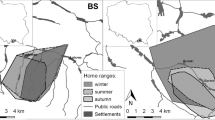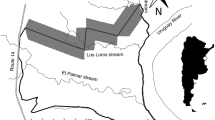Abstract
In the face of climate change and habitat fragmentation there is an increasingly urgent need to learn more about factors that influence species distribution patterns and levels of environmental tolerance. Particular insights can be obtained by looking at the edges of a species range, especially from species with wide distributions. The European roe deer was chosen as a model species due to its widespread distribution. By using pellet group counts, we studied summer and winter habitat use of this herbivore at two of the extreme edges of its distribution - southwest of Portugal, and northeast of Norway - in relation to a range of fine-scale environmental factors including forest structure, vegetation characteristics and human disturbance. Our first prediction that roe deer would respond differently to human activity in both counties was supported. While in Norway roe deer are always close to houses, in Portugal they are either far (in summer) or indifferent (winter). However, everywhere and in every season, roe deer are far from roads. Our second prediction that roe deer better tolerate anthropogenic disturbances in the area where the importance of limiting factors is higher (Norway) was validated. However, our third prediction that anthropogenic disturbance would be less tolerated by roe deer outside the limiting seasons in each country was not supported. Our results suggest that roe deer perceive human activities differently in the two countries and that roe deer better tolerate anthropogenic disturbances in Norway.
Similar content being viewed by others
References
Andersen, R., Duncan, P., Linnell, J.D.C., 1998. The European Roe Deer: The Biology of Success. Scandinavian University Press, Oslo.
Andersen, R., Gaillard, J.- M., Linnell, J.D.C., Duncan, P., 2000. Factors affecting maternal carein anincome breeder, the European roe deer. J.Anim. Ecol. 69, 672–682.
Andersen, R., Herfindel, I., Sæther, B.E., Linnell, J.D.C., Odden, J., Liberg, O., 2004. When range expansion rate is faster in marginal habitats. Oikos 107, 210–214.
Apollonio, M., Andersen, R., Putman, R., 2010. European ungulates and their management in the 21st Century.
Aragón, S., Braza, F., San José, C., 1995. Socioeconomic, physiognomic, and climatic factors determining the distribution pattern of roe deer Capreolus capreolus in Spain. Acta Theriol. (Warsz.) 40, 37–43.
Bates, D., Sarkar, D., 2006. lme4: Linear Mixed-effects Models using S4 Classes. R Package Version 0.9975-10, Available at: https://doi.org/cran.r-project.org/web/packages/lme4/index.html.
Blondel, J., Aronson, J., 1995. Biodiversity and ecosystem function in the Mediterranean basin: human and non-human determinants. In: Mediterranean-type Ecosystems: The Function of Biodiversity. Springer-Verlag, Berlin.
Borkowski, J., Ukalska, J., 2008. Winter habitat use by red and roe deer in pine-dominated forest. For. Ecol. Manag. 255, 468–475.
Brewka, A., Kossak, S., 1994. The influenceofatmospheric conditionsonthe mobility of roe deer (Capreolus capreolus L.) in winter. Ekol. Polsk. 40, 225–237.
Buckland, S., 1992. A review of deer count methodology. Report to Scottish Office Agriculture and Fisheries Department, p. 41 (unpublished).
Burnham, K.P., Anderson, D.R., 1998. Model Selection and Inference: A Practical Information – Theoretic Approach. Springer, New York.
Campbell, D., Swanson, G.M., Sales, J., 2004. Methodological insights: comparing the precision and cost-effectiveness of faecal pellet group count methods. J. Appl. Ecol. 41, 1185–1196.
Collins, W.B., Urness, P.J., 1981. Habitat preferences of mule deer as rated by pellet-group distributions. J. Wildl. Manag. 45, 969–972.
Edge, W.D., Marcum, C.L., 1989. Determining elk distribution with pellet-group and telemetry techniques. J. Wildl. Manag. 53, 621–624.
Faraway, J.J., 2006. Extending the Linear Model with R: Generalized Linear Mixed Effects and Nonparametric Regression Models. Chapman and Hall.
Faria, A.M.S., 1999. Dieta de corc¸ o (Capreolus capreolus L.) no Centro e Nordeste de Portugal. University of Coimbra, Coimbra.
Frid, A., Dill, L.M., 2002. Human-caused disturbance stimuli as a form of predation risk. Conserv. Ecol. 6, 1–16.
Gaston, K.J., 2003. The Structure and Dynamics of Geographic Ranges. Oxford University Press, Oxford.
Gill, R.M.A., Beardall, V., 2001. The impact ofdeeron woodlands: the effects of browsing and seed dispersal on vegetation structure and composition. Forestry 74, 209–218.
González-Megías, A., Gómez, J.M., Sanchez-Pin˜ero, F., 2005. Consequences of spatial autocorrelation for the analysis of metapopulation dynamics. Ecology 86, 3264–3271.
Guillet, C., Bergstrom, R., Cederlund, G., Bergstrom, J., Ballon, P., 1995. Comparison of telemetry and pellet-group counts for determining habitat selectivity by roe deer (Capreolus capreolus) in winter. Gibier Faune Sauvage 12, 253–269.
Hewison, A.J., Vincent, J.P., Joachim, J., Angibault, J.M., Cargnelutti, B., Cibien, C., 2001. The effects of woodland fragmentation and human activity on roe deer distribution in agricultural landscapes. Can. J. Zool. 79, 679–689.
Hoffmann, A.A., Blows, M.W., 1994. Species borders: ecological and evolutionary perspectives. Trends Ecol. Evol. 9, 223–227.
Je˛drzejewski, W., Jędrzejewska, B., Okarma, H., Ruprecht, A.L., 1992. Wolf predation and snow cover as mortalityfactors in the ungulate community of the Bialowiez a National Park, Poland. Oecologia 90, 27–36.
Jiang, G., Ma, J., Zhang, M., Stott, P., 2009. Multiple spatial-scale resource selection function models in relation to human disturbance for moose in northeastern China. Ecol. Res. 24, 423–440.
Kaluzinski, J., 1982. Dynamics and structure of a field roe deer population. Acta Theriol. (Warsz.) 27, 385–408.
Larcher, W., 2000. Temperature stress and survival ability of Mediterranean sclero-phyllous plants. Plant Biosyst. 134, 279–295.
Latham, J., Staines, B.W., Gorman, M.L., 1997. Correlationsof red (Cervus elaphus) and roe (Capreolus capreolus) deer densities in Scottish forests with environmental variables. J. Zool. 242, 681–704.
Lemmon, P.E., 1956. A spherical densiometer for estimating forest overstory density. For. Sci. 2, 314–320.
Lindén, H., Helle, E., Helle, P., Wikman, M., 1996. Wildlife triangle scheme in Finland: methods and aims for monitoring wildlife populations. Fin. Game Res. 49, 4–11.
Loft, E.R., Kie, J.G., 1988. Comparisonof pellet-group and radio triangulation methods for assessing deer habitat use. J. Wildl. Manag. 52, 524–527.
Mayle, B.A., Putman, R.J., Wyllie, I., 2000. The use of trackway counts to establish an index of deer presence. Mamm. Rev. 30, 233–237.
Melis, C., Basille, M., Herfindal, I., Linnell, J.D.C., Odden, J., Gaillard, J.-M., Høgda, K.-A., Andersen, R., 2010. Roe deer population growth and lynx predation along a gradient of environmental productivity and climate in Norway. Ecoscience 17, 166–174.
Miyashita, T., Suzuki, M., Ando, D., Fujita, G., Ochiai, K., Asada, M., 2008. Forest edge creates small-scale variation in reproductive rate of sika deer. Pop. Ecol. 50, 111–120.
Moreira, L.M., Rosa, J.L., Lourenc, O.J., Barroso, I., Pimenta, V., 1997. Projecto Lobo. Relatório de Progressão 1996 (Cofinanciado pela U. E. – Programa LIFE). Parque Natural de Montesinho, Braganc¸ a.
Mysterud, A., Bjornsen, B.H., Østbye, E., 1997. Effects of snow depth on food and habitat selection by roe deer Capreolus capreolus along an altitudinal gradient in south-central Norway. Wildl. Biol. 3, 27–33.
Mysterud, A., Lian, L.-B., Hjermann, D.O., 1999. Scale-dependent trade-offs in foraging by European roe deer (Capreolus capreolus) during winter. Can. J. Zool. 77, 1486–1493.
Mysterud, A., Østbye, E., 1999. Cover as a habitat element for temperate ungulates: effects on habitat selection and demography. Wildl. Soc. Bull. 27, 385–394.
Neff, D.J., 1968. The pellet-group count technique for big game trend, census, and distribution: a review. J. Wildl. Manag. 32, 597–614.
Odden, J., Linnell, J., Andersen, R., 2006. Diet of Eurasian lynx Lynx lynx, in the boreal forest of southeastern Norway: the relative importance of livestock and hares at low roe deer density. Eur. J. Wildl. Res. 52, 237–244.
Panzacchi, M., Herfindal, I., Linnell, J., Odden, M., Odden, J., Andersen, R., 2010. Tradeoffs between maternal foraging and fawn predation risk in an income breeder. Behav. Ecol. Sociobiol. 64, 1267–1278.
Panzacchi, M., Linnell, J.D.C., Odden, J., Odden, M., Andersen, R., 2008. When a generalist becomes a specialist: patterns of red fox predation on roe deer fawns under contrasting conditions. Can. J. Zool. 86, 116– 126.
Parmesan, C., Yohe, G., 2003. A globally coherent fingerprint of climate change impacts across natural systems. Nature 421, 37–42.
Pautasso, M., 2007. Scale dependenceof the correlation between human population presence and vertebrate and plant species richness. Ecol. Lett. 10, 16–24.
Pimenta, V., Correia, J., 2001. Distribuic¸ ão do corc¸ o (Capreolus capreolus) no Parque Natural do Douro Internacional: análise dos factores ambientais que a condi-cionam. Inst. Politécnico de Braganc¸a, Portugal.
Randall, M.G.M., 1982. The dynamics of an insect population throughout its altitu-dinal distribution: Coleophora alticolella (Lepidoptera) in Northern England. J. Anim. Ecol. 51, 993–1016.
Ratikainen, I.I., Panzacchi, M., Mysterud, A., Odden, J., Linnell, J., Andersen, R., 2007. Use of winter habitat by roe deer at a northern latitude where Eurasian lynx are present. J. Zool. 273, 192–199.
Rowland, M.M., Wisdom, M.J., Johnson, B.K., Kie, J.G., 2000. Elk distribution and modeling in relation to roads. J. Wildl. Manag. 64, 672–684.
Saïd, S., Servanty, S., 2005. The influence of landscape structure on female roe deer home-range size. Landsc. Ecol. 20, 1003–1012.
Stankowich, T., 2008. Ungulate flight responses tohuman disturbance:a review and meta-analysis. Biol. Conserv. 141, 2159–2173.
2009. Statistics Norway, https://doi.org/www.ssb.no/.
Tellería, J.L., Virgós, E., 1997. Distribution of an increasing roe deer population in a fragmented Mediterranean landscape. Ecography 20, 247–252.
Torres, R.T., Santos, J., Linnell, J.D.C., Virgós, E., Fonseca, C., 2011. Factors affecting roe deer occurrence in a Mediterranean landscape Northeastern Portugal. Mamm. Biol. 76, 491–497.
Tufto, J., Andersen, R., Linnell, J., 1996. Habitat use and ecological correlates of home range size in a small cervid: the roe deer. J. Anim. Ecol. 65, 715–724.
Vingada, J., Fonseca, C., Cancela, J., Ferreira, J., Eira, C., 2010. Ungulates and their Management in Portugal. Cambridge University Press, Cambridge.
Virgós, E., Telléria, J.L., 1998. Roe deer habitat selection in Spain: constraints on the distribution of a species. Can. J. Zool. 76, 1294–1299.
Wahlström, L.K., Liberg, O., 1995. Contrasting dispersal patterns in two Scandinavian roe deer Capreolus capreolus populations. Wildl. Biol. 1, 159–164.
Author information
Authors and Affiliations
Corresponding author
Rights and permissions
About this article
Cite this article
Torres, R.T., Virgós, E., Panzacchi, M. et al. Life at the edge: Roe deer occurrence at the opposite ends of their geographical distribution, Norway and Portugal. Mamm Biol 77, 140–146 (2012). https://doi.org/10.1016/j.mambio.2011.11.002
Received:
Accepted:
Published:
Issue Date:
DOI: https://doi.org/10.1016/j.mambio.2011.11.002




